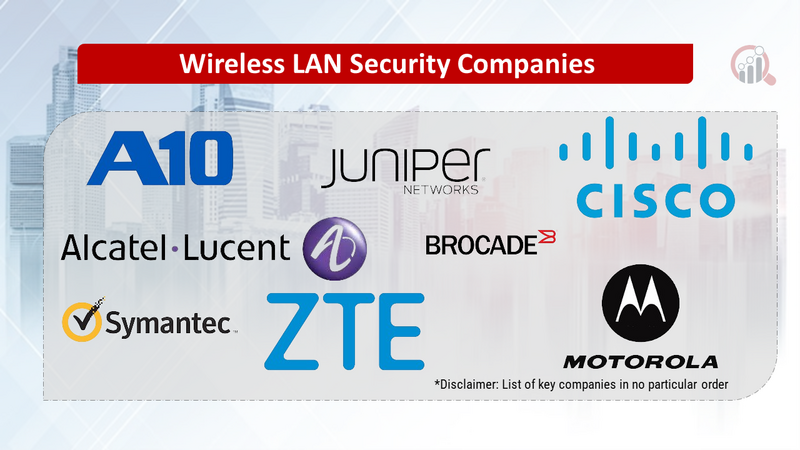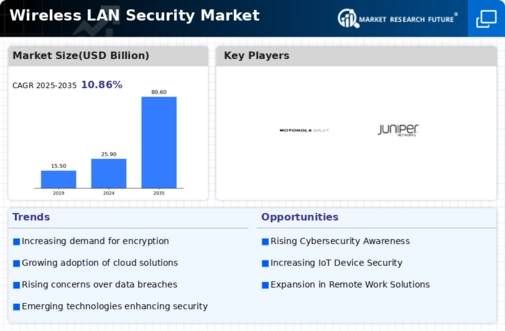Top Industry Leaders in the Wireless LAN Security Market

Wireless LAN Security Market: Dive into the Latest News and Updates
In today's wireless world, secure Wi-Fi connectivity is paramount. Businesses and individuals alike rely on wireless LANs (WLANs) for everyday tasks and critical operations, necessitating robust security measures to safeguard sensitive data and ensure network integrity. Enter the Wireless LAN Security Market, a rapidly expanding sector dedicated to protecting Wi-Fi networks from unauthorized access, data breaches, and cyberattacks.
Some of Wireless LAN Security Companies Listed Below:
- A10 Network (US)
- Motorola Solutions Inc. (US)
- Alcatel Lucent LA (France)
- Blue Coat Systems Inc. (US)
- Symantec Corporation (US)
- Brocade Communications System Inc. (US)
- ZTE Corporation (China)
- Cisco Corporation Inc. (US)
- Juniper Networks Inc. (US)
Strategies Driving Market Growth:
-
Focus on WPA3 Adoption: Companies offering compliant WPA3 solutions cater to the latest security standards, providing advanced encryption, stronger password authentication, and improved protection against network vulnerabilities. -
Zero-Trust Network Access (ZTNA) Integration: WLAN security solutions incorporating ZTNA principles grant access based on least privilege and continuous verification, minimizing attack surfaces and mitigating data breaches. -
AI and Machine Learning (ML) Integration: Leveraging AI and ML for automated threat detection, anomaly identification, and proactive security adjustments strengthens defenses against increasingly sophisticated cyberattacks. -
Cloud-Based Security Management: Offering cloud-based platforms for centralized WLAN security management, remote configuration, and real-time network monitoring simplifies security operations and improves visibility.
Market Share Decoding: Key Factors to Consider:
-
Product Portfolio and Feature Set: Companies offering diverse security features, including WPA3 support, ZTNA integration, AI-powered security, and cloud-based management, cater to broader needs and attract larger customer bases. -
Compliance Certifications and Industry Standards: Demonstrating compliance with data privacy regulations and industry security standards builds trust and ensures compatibility with existing IT infrastructure. -
Ease of Use and Deployment: Intuitive interfaces, simple configuration tools, and automated security features facilitate adoption and minimize reliance on specialized IT expertise. -
Cost-Effectiveness and Scalability: Affordable pricing models and scalable solutions catering to diverse network sizes and budget constraints make WLAN security accessible to a wider range of organizations and individuals.
New and Emerging Stars: Illuminating the WLAN Security Path:
-
Blockchain-Based Secure Authentication: Startups like WiBotic and Cambridge Wireless are exploring blockchain technology for secure device authentication and network access control, enhancing trust and mitigating unauthorized access risks. -
Quantum-Resistant Cryptography Integration: Companies like PQShield and QuSecure are developing WLAN security solutions incorporating quantum-resistant cryptography, preparing for the potential threat of quantum computing to existing encryption standards. -
Software-Defined Security Overlays: Startups like Altiplano Networks and Anomali offer virtualized security platforms that overlay existing WLAN infrastructure, providing flexible and dynamic security solutions across hybrid and multi-cloud environments.
Latest Company Updates:
October 25, 2023:
-
WPA3-SAE adoption accelerates due to WPA2 vulnerabilities: Organizations prioritize stronger encryption and password authentication measures. -
Focus on replacing outdated WPA2 networks: Eliminating vulnerabilities exploited in recent cyberattacks.
November 18, 2023:
-
Advanced phishing and social engineering attacks target Wi-Fi users: Techniques like rogue access points and fake captive portals aim to steal login credentials. -
Focus on user education and awareness: Training employees and home users to identify and avoid Wi-Fi security threats.
December 9, 2023:
-
Rise of mesh Wi-Fi systems with built-in security features: Automatic firmware updates, intrusion detection, and guest network isolation enhance overall security posture. -
Focus on holistic security solutions: Integrating network security with endpoint protection and threat intelligence.
January 8, 2024:
-
Wi-Fi 6E standard introduced, featuring enhanced security features: Improved cryptographic algorithms and channel hopping reduce vulnerability to targeted attacks. -
Focus on future-proofing networks: Early adopters prioritize Wi-Fi 6E for both performance and improved security.
February 7, 2024:
-
Zero-trust security principles applied to Wi-Fi networks: Continuous authentication and least-privilege access controls enhance perimeter security. -
Focus on layered defense and segmentation: Isolating critical segments and monitoring network activity for suspicious behavior.
February 14, 2024:
-
AI and machine learning (ML) integrated into Wi-Fi security solutions: Anomaly detection and threat prediction capabilities based on network behavior patterns. -
Focus on proactive threat prevention: Utilizing AI to identify and mitigate security risks before they can cause damage.

